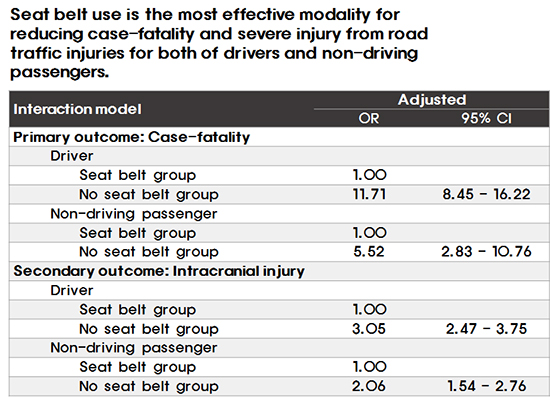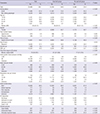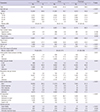1. Sise RG, Calvo RY, Spain DA, Weiser TG, Staudenmayer KL. The epidemiology of trauma-related mortality in the United States from 2002 to 2010. J Trauma Acute Care Surg. 2014; 76:913–919.
2. GBD 2013 Mortality and Causes of Death Collaborators. Global, regional, and national age-sex specific all-cause and cause-specific mortality for 240 causes of death, 1990-2013: a systematic analysis for the Global Burden of Disease Study 2013. Lancet. 2015; 385:117–171.
3. Lim D, Ha M, Song I. Trends in the leading causes of death in Korea, 1983-2012. J Korean Med Sci. 2014; 29:1597–1603.
4. Haider AH, Chang DC, Haut ER, Cornwell EE 3rd, Efron DT. Mechanism of injury predicts patient mortality and impairment after blunt trauma. J Surg Res. 2009; 153:138–142.
5. Nantulya VM, Reich MR. The neglected epidemic: road traffic injuries in developing countries. BMJ. 2002; 324:1139–1141.
6. Ian R, Irene K. Cochrane Injuries Group Driver Education Reviewers. School based driver education for the prevention of traffic crashes. Cochrane Database Syst Rev. 2001; CD003201.
7. Conner KA, Xiang H, Smith GA. The impact of a standard enforcement safety belt law on fatalities and hospital charges in Ohio. J Safety Res. 2010; 41:17–23.
8. Koushki PA, Bustan MA, Kartam N. Impact of safety belt use on road accident injury and injury type in Kuwait. Accid Anal Prev. 2003; 35:237–241.
9. Costich JF, Slavova SS. Using enforcement and adjudication data to assess the impact of a primary safety belt law. Traffic Inj Prev. 2015; 16:664–668.
10. Tunbridge RJ. The long term effect of seat belt legislation on road user injury patterns. Health Bull (Edinb). 1990; 48:347–349.
11. Elvik R, Vaa T. The handbook of road safety measures. Oxford: Elsevier;2004.
12. Cummings P, Wells JD, Rivara FP. Estimating seat belt effectiveness using matched-pair cohort methods. Accid Anal Prev. 2003; 35:143–149.
13. Salzberg P, Yamada A, Saibel C, Moffat J. Predicting seat belt use in fatal motor vehicle crashes from observation surveys of belt use. Accid Anal Prev. 2002; 34:139–148.
14. Vecino-Ortiz AI, Bishai D, Chandran A, Bhalla K, Bachani AM, Gupta S, Slyunkina E, Hyder AA. Seatbelt wearing rates in middle income countries: a cross-country analysis. Accid Anal Prev. 2014; 71:115–119.
16. Smith KM, Cummings P. Passenger seating position and the risk of passenger death in traffic crashes: a matched cohort study. Inj Prev. 2006; 12:83–86.
17. Pedley DK, Thakore S. Difference in injury pattern between drivers and front seat passengers involved in road traffic accidents in Scotland. Emerg Med J. 2004; 21:197–198.
18. Viano DC, Parenteau CS. Severe-to-fatal injury risks in crashes with two front-seat occupants by seat belt use. Traffic Inj Prev. 2010; 11:294–299.
19. Bose D, Arregui-Dalmases C, Sanchez-Molina D, Velazquez-Ameijide J, Crandall J. Increased risk of driver fatality due to unrestrained rear-seat passengers in severe frontal crashes. Accid Anal Prev. 2013; 53:100–104.
20. Smith KM, Cummings P. Passenger seating position and the risk of passenger death or injury in traffic crashes. Accid Anal Prev. 2004; 36:257–260.
21. Mayrose J, Priya A. The safest seat: effect of seating position on occupant mortality. J Safety Res. 2008; 39:433–436.
22. Ro YS, Shin SD, Holmes JF, Song KJ, Park JO, Cho JS, Lee SC, Kim SC, Hong KJ, Park CB, et al. Comparison of clinical performance of cranial computed tomography rules in patients with minor head injury: a multicenter prospective study. Acad Emerg Med. 2011; 18:597–604.
23. Lee KS. Estimation of the incidence of head injury in Korea: an approximation based on national traffic accident statistics. J Korean Med Sci. 2001; 16:342–346.
24. Kuo CY, Chiou HY, Lin JW, Tsai SH, Chiang YH, Lin CM, Chiu WT. Seatbelt use and traumatic brain injury in Taiwan: a 16-year study. Iran J Public Health. 2015; 44:470–478.
25. Lee LK, Monuteaux MC, Burghardt LC, Fleegler EW, Nigrovic LE, Meehan WP, Schutzman SA, Mannix R. Motor vehicle crash fatalities in states with primary versus secondary seat belt laws: a time-series analysis. Ann Intern Med. 2015; 163:184–190.
26. Carpenter CS, Stehr M. The effects of mandatory seatbelt laws on seatbelt use, motor vehicle fatalities, and crash-related injuries among youths. J Health Econ. 2008; 27:642–662.
27. Fildes B, Fitzharris M, Koppel S, Vulcan P, Brooks C. Benefits of seat belt reminder systems. Annu Proc Assoc Adv Automot Med. 2003; 47:253–266.









 PDF
PDF ePub
ePub Citation
Citation Print
Print




 XML Download
XML Download